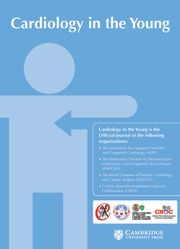No CrossRef data available.
Article contents
An infant case of autosomal recessive polycystic kidney disease-associated dilated cardiomyopathy-like hypertensive cardiomyopathy diagnosed because of urinary tract infection
Published online by Cambridge University Press: 13 September 2024
Abstract
We report a case of dilated cardiomyopathy-like hypertensive cardiomyopathy (HTN-CM) with polycystic kidney disease without family history when a 3-month-old boy developed bacteraemia secondary to a urinary tract infection. He was later confirmed as having autosomal recessive inheritance due to the proven PKHD1 gene mutation. The treatment consisted mainly of antihypertensive and anti-heart failure therapies and he was discharged on the 131st day. To prevent the development of heart failure in patients with HTN-CM due to autosomal recessive polycystic kidney disease (ARPKD), it is important to improve the fetal diagnosis rate of ARPKD, detect hypertension early, and strictly control the blood pressure after birth.
Keywords
- Type
- Brief Report
- Information
- Copyright
- © The Author(s), 2024. Published by Cambridge University Press



